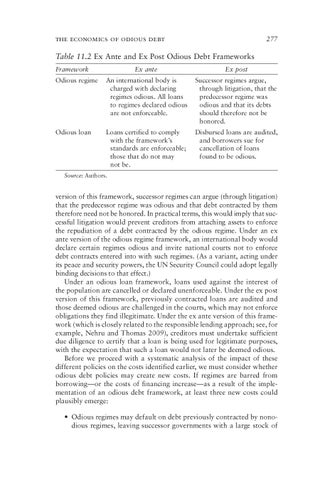the economics of odious debt
277
Table 11.2 Ex Ante and Ex Post Odious Debt Frameworks Framework
Ex ante
Ex post
Odious regime
An international body is charged with declaring regimes odious. All loans to regimes declared odious are not enforceable.
Successor regimes argue, through litigation, that the predecessor regime was odious and that its debts should therefore not be honored.
Odious loan
Loans certified to comply with the framework’s standards are enforceable; those that do not may not be.
Disbursed loans are audited, and borrowers sue for cancellation of loans found to be odious.
Source: Authors.
version of this framework, successor regimes can argue (through litigation) that the predecessor regime was odious and that debt contracted by them therefore need not be honored. In practical terms, this would imply that successful litigation would prevent creditors from attaching assets to enforce the repudiation of a debt contracted by the odious regime. Under an ex ante version of the odious regime framework, an international body would declare certain regimes odious and invite national courts not to enforce debt contracts entered into with such regimes. (As a variant, acting under its peace and security powers, the UN Security Council could adopt legally binding decisions to that effect.) Under an odious loan framework, loans used against the interest of the population are cancelled or declared unenforceable. Under the ex post version of this framework, previously contracted loans are audited and those deemed odious are challenged in the courts, which may not enforce obligations they find illegitimate. Under the ex ante version of this framework (which is closely related to the responsible lending approach; see, for example, Nehru and Thomas 2009), creditors must undertake sufficient due diligence to certify that a loan is being used for legitimate purposes, with the expectation that such a loan would not later be deemed odious. Before we proceed with a systematic analysis of the impact of these different policies on the costs identified earlier, we must consider whether odious debt policies may create new costs. If regimes are barred from borrowing—or the costs of financing increase—as a result of the implementation of an odious debt framework, at least three new costs could plausibly emerge: • Odious regimes may default on debt previously contracted by nonodious regimes, leaving successor governments with a large stock of
